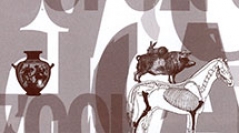

 Anthropozoologica
47 (1) - Pages 323-344
Anthropozoologica
47 (1) - Pages 323-344In Athens, on a series of votive steles discovered in Munychia, Zeus Meilichios is represented typically as the “bearded snake”, easily recognized by the appendix under the reptile’s throat. This representation suggests the ambivalence of the contradictory values assumed by the god, benevolent and protective, but also fearsome and vengeful, as shown in an analysis of Athenian mythical and religious traditions. The same applies to various other divine or heroic figures. Thus this peculiarity seems to take on a symbolic meaning and one might see it as an iconic motif suggesting a dual identity. But, as in the case of the “cheek snake”, can this motif also be explained in reference to a real peculiarity, specific to a species of reptile known to the ancient Greeks ? The idea of a reference to a particular species of snake can enlighten and enrich our understanding of the “bearded snake” motif, without howewer enabling us to reach a definitive conclusion.
Zeus Meilichios, Diasia, Athens, Bearded Snake, Religion, Rituals, Sacrifice, God, Heroes, Duality, Iconography.